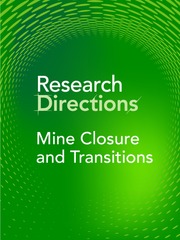The definition of the future use of mined lands should be considered early in the life cycle of a mine. Well-established concepts, such as “Begin with the end in mind” or “Design for closure,” have at their core the idea of having in mind the intended use of the mined area before the cessation of operational activities. However, closure is complex and the optimal future use of a mined area involves evaluation of environmental, social, and economic aspects, all of which change through the life of a mine. Closure is also a dynamic and iterative process that needs to be integrated into operations, while accounting for the possibility of temporary or sudden closure (ICMM, 2019).
One of the apparent main hurdles for companies in achieving effective mine closure is the costs involved in the process, which are often not factored in through the life of mine. Progressive closure helps reduce and spread these costs but does not eliminate the “sunk costs” for companies (Nehring and Cheng, Reference Nehring and Cheng2016) since, in many cases, the future use is intended to be returning the area to a natural ecosystem. In this context, repurposing presents an excellent closure opportunity that offers the possibility of generating post-mining value and attracting investment using new and innovative technologies and solutions. Approaches based on the circular economy, ecological engineering, nature-based solutions, renewable energy, water resource development, bioremediation, tourism, recreation among others, open new possibilities for future uses of formerly mined areas.
Examples of new technologies that may generate economic opportunities for the future use of mined lands include the transformation of tailings and mined rock stockpiles into economically valuable products (Bian et al., Reference Bian, Mioa, Lei, Chen, Wang and Struthers2012) or healthy soils (Ruiz et al., Reference Ruiz, Cherubin and Ferreira2020), the establishment of power plants for the generation of renewable and clean energies (Bakhtavar et al., Reference Bakhtavar, Aghayarloo, Yousefi, Hewage and Sadiq2019), the restoration of mined areas for the purposes of carbon capture and storage (contributing to decarbonization goals) (Khlifa et al., Reference Khlifa, Rivest, Grimong and Bélanger2023; Ruiz et al., Reference Ruiz, Safanelli, Perlatti, Cherubin, Demattê, Cerri, Otero, Rumpel and Ferreira2023), the use of hyperaccumulator plants for the recovery of residual metals in tailings (agromining) (Van der Ent et al., Reference Van der Ent, Baker, Echevarria, Simonnot and Morel2021), and microbial control of contaminants or bioleaching of metals (Nguyen et al., Reference Nguyen, Won, Ha and Kang2021; Levett et al., Reference Levett, Gagen, Levett and Erskine2023). On one hand, these technologies offer not only economic benefits for companies seeking to offset closure costs but also value for a range of stakeholders affected by mine closure and the future land use. On the other hand, many of these innovative approaches have essential underpinning land and/or water prerequisites that mean they are not appropriate or achievable at every site, and such challenges and limitations will need to be overcome for successful and sustainable mine repurposing.
Therefore, considering the perspectives set out above we invite papers that address challenges relating to repurposing, including:
-
Implementation of large-scale circular approaches to mine closure planning, including topics such as waste-to-value, “re-economization” and reclamation economies.
-
The regulatory constraints for repurposing mined lands and developing post-closure economies, considering the heterogeneity of rules in different jurisdictions.
-
Existing models or examples that encourage de-risk or incentivize economic repurposing.
-
Stakeholder engagement and cooperation for sustainable repurposed futures, beyond the stewardship of the mining company.
-
Technologies that offer the promising new pathways for repurposing of formerly mined areas.
-
Categorization of the assets of a mine (infrastructure or land) for various repurposing options.
-
Data-driven analyses that demonstrate the business case and feasibility for repurposing of formerly mined areas.
How to contribute to this Question
If you believe you can contribute to answering this Question with your research outputs find out how to submit in the Instructions for authors. This journal publishes Results, Analyses, Impact papers, and additional content such as preprints and “gray literature.” Questions will be closed when the editors agree that enough has been published to answer the Question so before submitting, check if this is still an active Question. If it is closed, another relevant Question may be currently open, so do review all the open Questions in your field. For any further queries, check the information pages or contact this email mines@cambridge.org.
Competing interests
The author declares none.




